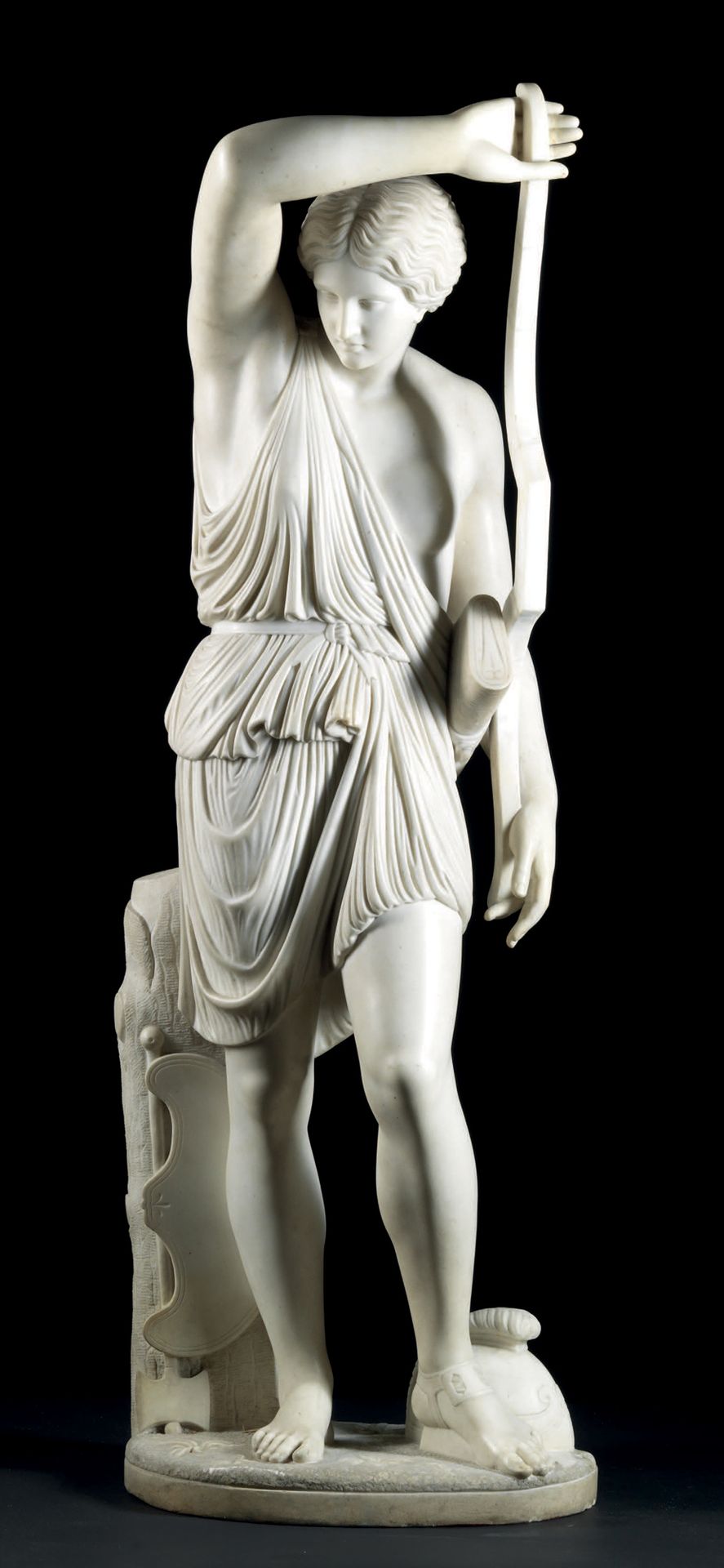Description
WOUNDED AMAZONE Italy, 19th century White Carrara marble Repaired damages to the bow and the fingers of the left hand H. 115 cm, W. 43 cm, D. 31 cm This female figure dressed in the antique style, head bent, arm raised above the head sheathing her bow, quiver falling on the left hip, is a wounded Amazon. The helmet on the ground next to her left foot, her shield and axe attached to a pruned trunk in the manner of a trophy of arms recall the theme of the defeated Amazon, dear to the Athenian culture of the 5th century BC. Our sculpture is in fact a reproduction of the wounded Amazon in the Capitoline Museum (fig. 1). This ancient statue, found very damaged in the excavations of the Villa d'Este near Rome, had been offered to Benedict XIV in 1753. Its restoration was entrusted to the Roman sculptor Bartolomeo Cavaceppi (1715/1716-1799) who restored its head and bow. Pliny the Elder tells how the decoration of the temple of Artemis in Ephesus was the subject of a competition between Phidias, Polyclitus, Criselias and Phradmond between 440 and 430 BC. Each of the four Hellenistic sculptors created a wounded Amazon, whose lost originals are known from Roman copies. Ours, with its bow and helmet, corresponds to the model sculpted by Phidias (fig. 2). The ancient marble preserved in the Vatican, which comes from the collection of Duke Giuseppe Mattei, was often copied in the 19th century, as can be seen, for example, in the Mattei Amazon in the Academy of Fine Arts in Carrara, or in the ones that adorn the Château de Vincennes, the Cour carrée of the Louvre, the gardens of Peterhof... All of them are without bows, and their heads, with their rough features, stand out from the wise hair that accompanies the gentle face of our Amazon. This is because Bartolomeo Cavaceppi, in the eighteenth century, would have preferred the heads of Polyclitus from which he drew inspiration to complete the statue of the Capitol.
109
WOUNDED AMAZONE Italy, 19th century White Carrara marble Repaired damages to the bow and the fingers of the left hand H. 115 cm, W. 43 cm, D. 31 cm This female figure dressed in the antique style, head bent, arm raised above the head sheathing her bow, quiver falling on the left hip, is a wounded Amazon. The helmet on the ground next to her left foot, her shield and axe attached to a pruned trunk in the manner of a trophy of arms recall the theme of the defeated Amazon, dear to the Athenian culture of the 5th century BC. Our sculpture is in fact a reproduction of the wounded Amazon in the Capitoline Museum (fig. 1). This ancient statue, found very damaged in the excavations of the Villa d'Este near Rome, had been offered to Benedict XIV in 1753. Its restoration was entrusted to the Roman sculptor Bartolomeo Cavaceppi (1715/1716-1799) who restored its head and bow. Pliny the Elder tells how the decoration of the temple of Artemis in Ephesus was the subject of a competition between Phidias, Polyclitus, Criselias and Phradmond between 440 and 430 BC. Each of the four Hellenistic sculptors created a wounded Amazon, whose lost originals are known from Roman copies. Ours, with its bow and helmet, corresponds to the model sculpted by Phidias (fig. 2). The ancient marble preserved in the Vatican, which comes from the collection of Duke Giuseppe Mattei, was often copied in the 19th century, as can be seen, for example, in the Mattei Amazon in the Academy of Fine Arts in Carrara, or in the ones that adorn the Château de Vincennes, the Cour carrée of the Louvre, the gardens of Peterhof... All of them are without bows, and their heads, with their rough features, stand out from the wise hair that accompanies the gentle face of our Amazon. This is because Bartolomeo Cavaceppi, in the eighteenth century, would have preferred the heads of Polyclitus from which he drew inspiration to complete the statue of the Capitol.
